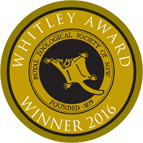Australian Birdlife magazine review
An Atlas of the Birds of NSW & the ACT Volume 2
By Richard M Cooper, Ian AW McAllan, Christopher CP Brandis and Brian R Curtis
New South Wales Bird Atlassers Inc.
Bird atlases can be a mixed bag. Some are simply books of dots on maps, but others offer a treasure trove of valuable information. An Atlas of the Birds of NSW& the ACT Volume 2 is the latter, and a standout among the many Australian bird atlases.
The second book in a three-volume set and covering 165 resident and migratory species from Comb-crested Jacana to Striated Pardalote, it is filled to the brim with information. No reader could ever be left wondering.
All species have at least a basic distribution map, and most have additional maps which detail reporting rates and breeding distribution, with some also having their seasonal distribution (e.g. Red-backed Kingfisher) or historical distribution illustrated (e.g. Spotted Bowerbird). Each map shows the state’s major river systems to provide a geographical context to the bird’s distribution.
The species accounts offer concise summaries of each bird’s distribution (worldwide, within Australia and in NSW, and some discuss overlap zones of similar species which could cause confusion (e.g. Brown and Inland Thornbills). Habitat, breeding ecology, seasonal movements, early records and changes in distribution, and status (including population trends) are also outlined.
Each species account is specially tailored, expanding on specific aspects of its movements, ecology or whatever else is appropriate.
But wait, there’s more! There are tables that provide a regional breakdown of seasonal reporting rates, and graphs that show breeding by month, as well as different permutations of reporting rates (monthly, annual and various others).
There’s just so much information. With any book that contains this amount of detail, there are bound to be a few quibbles. There are.
One concerns the maps themselves. Some state boundaries are either not marked, or if they are, they are obscured (the SA border is implied, while the majority of the border with Queensland is left to the imagination) which makes interpretation of some species’ ranges rather unclear (especially near the northern boundary).
Further confusing matters, an extra row of grids is included in the north, extending each map into south-western Queensland by over 100 kilometres. It’s misleading and an unnecessary downside to a book that relies on graphic depiction of species distribution. It could be easily rectified by having the borders boldly marked or by removing most of the uppermost row of grids.
Intriguingly, the index is hidden near the front of the book (why it’s not at the back is anybody’s guess). I only discovered it belatedly and by accident after I was compelled to flick through the 670 pages in the vague hope of finding a particular species.
These minor quibbles aside, it’s a wonderful atlas-jam-packed with useful information which should be welcomed by ornithologists and recreational birdwatcher’s alike. The complete set, when it’s finished will be a great (and weighty) addition to your bookshelves.
By John Peter
Australian Birdlife Vol. 5 No. 3 September 2016 Page 86









